With a multitude of right digital pianos on the market, finding an instrument that caters to your kind of musical orchestration could become a challenging task. Whether you are a beginner, an intermediate user, or a professional pianist, this review can come in handy to find a top-rated digital piano to suit your style of play. What’s more, is the affordability of the listed pianos which are all priced under $1000. Here’s a comprehensive review that can help you understand the key features, pros, and cons of these best digital pianos under $1000 so that you can instantly begin to create the best sound of music.
Quick Summary: Best Digital Pianos Under 1000 Dollars
Also Check out:- Best Digital Pianos Under $500
Top 9 Best Digital Pianos Under $1000
#1. Kawai ES110 Stage Digital Piano – Best Overall
What’s Best in Kawai ES110?
- The ES-110 offers an easy-to-use 3-song built-in recorder.
- It features dual and split keyboard modes and features a built-in stereo speaker system.
- Superlight and easily portable piano with the best sound.
What’s Lacking in Kawai ES110?
- Doesn’t work with batteries and is compatible only with AC power.
- Doesn’t come with a stand and pedals.
This is perhaps one of the best digital pianos that you can find for under $1000 but is still packed with great sounds for an authentic piano playing experience. The piano still has 88 keys with graded hammer action, MIDI control, 19 external sounds, 192 note polyphony along with built-in Alfred piano lessons for an authentic piano playing experience within budget. Even intermediate players can start sounding professional by affording this high-end digital piano.
This piano is of the highest quality plastic and is available in white and black colors. It is portable, you can take it to consorts, piano classes and also to parties to impress your friends. The Kawai ES110 features a MIDI jack that is great for connecting with other musical instruments, computers, and gadgets. This piano is capable of exhibiting an exceptional piano experience and makes use of the acclaimed harmonic imaging sound technology.
The one best thing that we loved in this piano is its feel, and the keys move as your fingers move, rendering an authentic piano playing experience. Apart from the standard MIDI ports, the new ES110 also bags on its integrated Bluetooth MIDI technology, allowing the digital piano to communicate with other smart devices wirelessly.
Check out: Top 10 Best Digital Pianos for Intermediate players
#2. Casio Privia PX-770 BK Digital Piano – Runner Up
What’s Best in Casio Privia PX-770?
- Flaunts a slim space saver design
- Ideal for beginners but can be used by any level of pianist
- Features a USB connector and headphone
- Provides the advantage of concert play
What’s Lacking in Casio Privia PX-770?
- Lacks the audio-recorder
- The sound customization options are limited
- It lacks the terminals for connecting flash drives
If you are looking for a digital piano for your home, the Casio Privia PX-770 BK model in black oozes pure magic. Designed with the AiR engine, this model is meant to offer accuracy in sound and performance. Casino Privia lives to its brand image with quality embodied in slim and modern piano design. You can rejoice in the sound effects of an authentic piano on the Casio Privia PX-770. It offers a natural feel and is cast with impressive features. A brilliant instrument for beginner-level pianists, this one is worth a buy.
Features
- PX-770 features a tri-sensor 2 scaled hammer action keyboard that gives the piano a remarkable feel. You can enjoy the speed and accuracy of the incredible dynamics offered by the piano.
- AiR sound source improves sound quality
- It is designed with a stereo that amplifies the sound with excellent clarity.
- The duet mode on the Casio Privia splits it into two equal pitch ranges making it a perfect instrument for beginners who can sit together with their teachers for their piano lessons
- The concert play feature enables playing along with recordings. There are 10 pre-set orchestral pieces programmed in the piano.
- There are two acoustic stimulators in the PX-770 BV Casio Privia: Damper resonance and Hammer resonance.
- Casio Priva can be connected to a Windows or Mac device via the USB port
- It can be connected to an Android or iOS device to use the Chordana Pay App for free. This app enables you to view the notations and lyrics of your choicest songs on the piano’s display screen.
- Features Metronome, Transpose, Fine-tuning and Octave shift
Also check: Best Beginner Digital Pianos & Keyboards 2024
#3. Yamaha P71 Digital Piano – Editor’s Choice
| Features | Rating |
| Performance and sounds | 9.5 |
| Connectivity | 9.1 |
| Build Quality | 9.1 |
| For Beginners | 9.7 |
| Value for money | 9.6 |
What’s Best in Yamaha P71?
- Yamaha P71 is lightweight and portable
- The 88-keys characterize this piano as a full-size one
- 10 varying voices offer a variety to choose from
What’s Lacking in Yamaha P71?
- Doesn’t come with a stand
- No LED screen
An ideal electronic piano for your home, the Yamaha P71 weighted digital piano can be used for learning and creating melodious music. This piano features a life-size keyboard with weighted keys. This model from Yamaha is slim and stylish. With a 12” depth, it can be placed in any corner of your house. This classic piano encased in a contemporary design weighs only 25 lbs and features an in-built sound system.
Features
- The Graded Hammer Standard weighted action of Yamaha P71 offers a heavier touch in the lower end and a lighter touch in the high end. This is typical of the acoustic piano and gives this digital piano an authentic touch.
- One button for all functions makes the piano a user-friendly instrument. The grand piano function button can be used to access the keys that can change voices, configure to a metronome, play demo sources and complete more actions as desired.
- It is enabled with AWM or Advanced Wave Memory sampling. This uses digital technology to record sound-generating the impact of an acoustic piano. With its ability to play one sample per note at different levels of volume and resonance, this piano from Yamaha creates a deeper and richer sound.
- Features 2 microphones
- Yamaha P71 digital piano is slim with a space-saver design
- The piano contains 10 different voices that offer a variety. The dual-mode allows combining two voices. For instance, you can combine strings and piano at a time.
Also check: Top 11 Best Home Digital Pianos of 2024
#4. Roland FP-30 – Great Intermediate Keyboard Under $1000
| Features | Rating |
| Performance and sounds | 9.5 |
| Lightweight | 9.1 |
| Connectivity | 9.1 |
| Build Quality | 9.3 |
| Value for money | 9.5 |
What’s Best in Roland FP-30?
- The compact size of the piano adds to its portability
- 22 W powerful on-board speakers
- Supports Bluetooth MIDI connectivity
- Can play MIDI and WAV files from a flash drive
- Ivory key-feel is great for a long duration of practice making this piano a considerable choice for beginners
What’s Lacking in Roland FP-30?
- Limited sound customization options
- Doesn’t feature a lesson function
Features
- The engine of the piano is designed as a powerful onboard sound system. It has an advanced keyboard, sensitive to touch.
- The Ivory-feel keys provide a high-end feel to the piano.
- Plugin your headphones for a fantastic sound effect without disturbing anyone around
- A portable instrument, this piano looks elegant. It can be placed conveniently within tight living spaces
- The KSC 70 stand and the KPD 70 three-pedal unit provide a cohesive appearance to the piano. The smaller footprint renders the Roland portable a sleek look.
- The three-pedal unit can be used for hands-free turning of your onscreen music reference pages. You can use the ‘Sheet Music Direct’ or the ‘piaScore’ apps to connect your instrument with your mobile.
- You can record and play along with your favorite songs as you connect the USB memory.
- Another exclusive feature of this Yamaha portable piano model is the twin piano mode. It allows students and teachers to play and learn together.
This digital piano from Roland features the standard 88 keys. It is enabled with a responsive tone that provides the same authentic touch as a piano. The FP-30 BK has a powerful amplifier and stereo speakers that create a genuine piano sound. It comes with headphones that allow users to enjoy playing it without disturbing others. With its 3 pedal stand, this piano from Roland offers enhanced functionality. Users can turn pages without using their hands; thanks to the music apps. This piano is lightweight, thus making it easily transportable. You can play it indoors or place it outdoor for a performance.
FP-30 BK is enabled with a built-in Bluetooth facility so that you can connect it with popular apps on your mobile devices. This digital piano allows users to widen their musical experience by combing dual sounds. For instance, in the split mode, you can combine sounds of strings with drums, organs, or even voices.
Also check: Best Digital Pianos Under $700
#5. Roland RP102 Digital Piano – Good Choice
What’s Best in Roland RP102?
- Partners with the Piano Partner 2 app to learn the piano lessons faster
- Connects wirelessly to other gadgets through Bluetooth
- Elegant piano in a space-saving design
- Three pedal controls with metal construction for an authentic piano feel.
What’s Lacking in Roland RP102?
- Doesn’t come with a bench
- Doesn’t have a recording function
If you are looking for a piano that matches your lifestyle, your budget, and the space at home, then you should be choosing the Roland RP102 digital piano. This is an excellent piano that renders an authentic piano performance and it helps with a great piano playing experience in a compact design. Though its cost is slightly at a higher-end, around $1000, it is worth spending as this piano packs the best technologies along with many luxurious features.
Its weighted hammer action keyboard is packed with supreme features for rendering inspiring sounds and touch.
Its supernatural piano playing technology helps in delivering authentic tine and response of an efficient acoustic grand piano and its standard keyboard comprises a refined sensing technology that helps in inculcating great expressions with tunes.
As this piano features a digital design, there is no need for regular tuning or costly maintenance, which makes the Roland a great piano for home, studios, practice rooms, and other settings mandating music education.
The piano allows the users to enjoy exceptional piano sounds at the touch of its controls. With just the touch of a button, it is possible to adjust the volume, bring in new tones and instrument sounds and bring its dynamic speakers to life, to fill the entire room with great piano music. There are more than 200 ready-to-play songs on this piano and you can also choose to plug in the headphones for an immersive music experience.
Also check: Best Digital Pianos Under $2000
#6. Casio PX-S3000 – Alternative for Casio Brand Lovers
What’s Best in Casio PX-S3000?
- Its AiR sound engine has also undergone an up-gradation with new sample sets.
- The sounds of this piano are sampled from a 9-foot concert grand piano.
- The PX- S3000 comes preloaded with six demo songs, for practice.
- There are two mini-stereo headphone jacks to connect with headphones.
What’s Lacking in Casio PX-S3000?
- The in-built speakers of the piano are not too great.
- Glossy finish demands extensive maintenance.
This piano will not disappoint those who are serious about their piano lessons and can be a great companion for hobbyists as well. The first best thing about this piano is that, it comes in a perfect shape and all of its keys sound great and its controls function to the point. It sounds great and thus can be a great companion for all the stage shows. Casio has indeed performed tremendous research and hard work to transcend its image of manufacturing toy keyboards and prove its capability to manufacture professional and realistic pianos. The PX series is the brainchild of that effort. The Privia line of portable digital pianos with professional keyboards and exceptional sound quality.
The alphabet S in the Casio PX-S3000 is a mark of its ‘slim factor’. It is an extremely lightweight and portable piano that weighs slightly over 11 kg. Transporting the piano to the music classes and the stage shows will now be as easy as a cakewalk. The S3000 features a glossy plastic finish, which is also a fingerprint magnet on the downside. But the finish renders it a professional and beautiful look at the very first glimpse.
The control panel looks plain and simple as there are buttons only for power and volume. There is also a pitch bend wheel and two assignable knobs. You can also make use of the Chordana Play app for iOS and Android users to get accustomed to the controls and functions better. Also, this piano is battery powered and we will require 6 AA batteries for two hours of continuous playtime. You can also choose to plug into the power supply if available.
#7. Yamaha Arius YDP-144 Piano – Good for Advanced Pianists Under $1000
What’s Best in Yamaha Arius YDP-144?
- Half damper pedal control for increasing the sustains gradually.
- Special matte finish keytops to absorb moisture and to prevent slipping
- Fashionable piano with a powerful grand piano tone
What’s Lacking in Yamaha Arius YDP-144?
- The piano is pretty heavy, about 38 kg, so shifting it between rooms is tough.
- The piano comes partly assembled and you have to complete the rest by yourself.
Your purchase includes a grand digital piano, bench, three-pedal systems, 50 classical music masterpieces books, and an owner’s manual along with a quick operations guide. The pianos from the Yamaha YDP series are the best bet for their cost and a must-have instrument in every person’s home who is interested in Music. There is a light matte finish over the keys to avoiding slipping and there are pedals built into the body. You can enjoy a realistic playing experience as its damper pedal supports half-pedaling.
There are a limited number of controls, and thus it is mandatory that the pianist has to be proficient with several key combinations to access definite functions. The YDP 144 features a full weighted 88-keys keyboard with a glide cover. The keys function with a graded hammer action, which is ideal for that pianist who is serious about their music. Like the other flagship models of Yamaha, the YDP 144 has also exported its sound from the CFX concert grand piano and no doubt it features an expensive and unique tone.
The intelligent acoustic control of this piano along with its inbuilt sound helps with authentic piano playing experiences. The YDP 144 features a 192 note polyphony, which is good enough to play a good number of songs with all types of notes. The Yamaha YDP 144 comes with three inbuilt effects and four reverbs such as chamber reverb, club reverb, recital hall, and concert hall to add more effect to the music.
Also check: Top 14 Best Digital Pianos for Advanced Pianist
#8. Korg LP380 Digital Piano – Stylish Design
What’s Best in Korg LP380?
- Slim and a stylish piano with premium pedal performance
- Compatible with MIDI and holds other connectivity features.
- Complimented with a real weighted hammer action keyboard
- Features a great-sounding speaker that is good to fill a big room with music.
What’s Lacking in Korg LP380?
- Doesn’t come with a bench and headphones.
This is a budget piano that is available for under $1000, features a low profile and a slim cabinet, and brings in brilliant piano sounds along with an excellent piano action, something that budding pianists aspire in their musical instrument. There are about 30 expressive and high-quality sounds in this piano, which encompasses the sounds of strings, electric pianos, and a lot more.
This is a perfect teaching piano as well, as its partner mode divides the keyboard into specific right and left octaves at the same time, which is perfect for teaching.
Its layer mode allows the sounds to be played together for exorbitant music playing experience.
The piano features two headphone jacks to enable two people to play the piano together and its large pedals and speakers render an authentic piano playing experience.
The piano also blends seamlessly with the existing décor of the home with the availability of its five different color variations.
The piano features a slim and stylish design and delivers rich and dynamic piano sounds that are derived from its Kronos music workstation. Its high-output amp section is capable of producing lots of music and volume and its users will love its decreased chassis, well-packed size, and exceptional weight. The piano also features a three-pedal design with elegant half-damper support.
#9. Donner DDP-90 Digital Piano – Suits All Skill Levels
What’s Best in Donner DDP-90?
- Dual stereo speakers with perfect sound capability
- Capable of supporting multiple devices and renders great and original sounds of a grand piano.
- 128 polyphonies with AWM sampling for realistic sounding and stunning performance.
What’s Lacking in Donner DDP-90?
- The piano doesn’t come with a chair or bench
This is an exceptional beginner digital piano for professional players with three pedals. It connects seamlessly with the cellphone, tablet, and personal computers of its users and also features Audio input and output features. It appeals to both beginners and advanced piano players as its 88-key hammer action keyboard renders high-quality sound samples from real grand acoustic pianos.
The piano features 128 polyphony and a three-pedal system to play the soft, sostenuto, and sustain music in tune with the keystrokes. As this piano comes with a U-disk, MP3 connection capability, and a built-in amplifier, it is possible to establish a connection between the piano and the PC, smartphone, laptop, or tablet easily. It features external sound support and connects with the external speakers easily. It is also compatible with the headphone and its headphone jack is located at the bottom left of the piano.
The piano features a beautiful and practical design and its excellent flip cover features a slow closing function, to protect both the keys and the hands of the musician. As they have redesigned the body of the piano to a smaller structure, it looks compact and occupies little space, but there is no compromise on the sound quality and other features of the piano. It finds perfect application in smart apartments and dormitories too and can be great for beginners and helps them attain the perfect pitch easily.
Related Reading: Best Digital Pianos for Classical Pianists
Our Recommendation
Regardless of your level, an electronic piano with advanced features can enhance your performance and help improve your skills. Whether you want to practice for a live gig or a studio performance, you can pick any model from the above-reviewed list of best digital pianos under $1000 to begin your musical journey on a high note.
Frequently Asked Questions (FAQs)
Why is ear training important?
A musician’s performance can benefit from ear training. The capacity to recreate a note’s sound or recognise it depending on its position in connection to another note is called relative pitch, and it can be improved through ear training. This ability enables you to examine and interpret what you hear, improving your comprehension of the connections between musical elements. By developing your ear, you may boost your improvisational and sight-singing abilities as well as your rhythm, instrument tuning, and playing with other musicians.
What is pitch ear training technique?
By performing the same note repeatedly while humming or singing it, you can train the ear to recognise notes by mentally connecting the sound of the note with its name. Your ability to recognise pitches will improve the more vividly you can sense a chord in your thoughts.
What is the chord ear training technique?
A chord is created by playing three notes simultaneously. You may build better-sounding chords in your music and even induce certain emotional effects by training your ear to recognise the type of chord you’re hearing or which notes sound great together. For instance, major chords are more frequently employed in music to convey good emotions, whereas minor chords are frequently used to convey negative emotions. Try to determine whether a chord is major, minor, reduced, or augmented by listening to a variety of them.
What are the features of a Grand piano?
The grand piano has the following features:
– More dynamic, rich, and varied sonority that ranges from pianissimo to fortissimo
– Improved sustain
– A tone that is stronger
– Increased capacity to bring nuance to notes
– Consistent and well-balanced sound
– Improved note repetition skills
What are the challenges of learning piano online?
Learning can be challenging if you have a poor internet connection. It may be difficult to make corrections without a physical presence. Should make sure to have the necessary tools so that both the teacher and the student can see each other properly when playing.
What is interval ear training technique?
The recognition of intervals is a crucial part of ear training. It can be simpler for you to recognise and imitate tunes later on if you learn all the intervals contained inside an octave. To teach your ear to quickly detect intervals, become familiar with the forward and backward directions. You can more easily determine which notes span an octave or which are compound intervals thanks to interval training, which enhances your ear’s capacity to distinguish the distance between two pitches (larger than an octave). You can construct sets of chords that are attractive to the ear if you have a good grasp of the spacing between pitches.


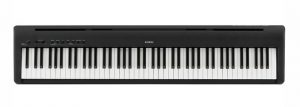
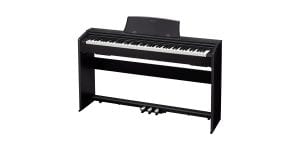
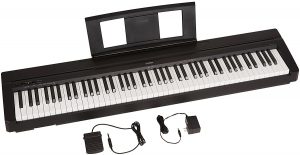
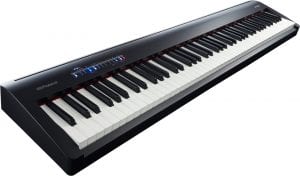
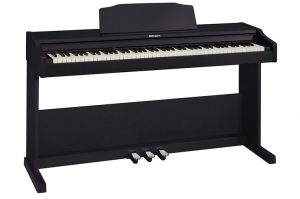
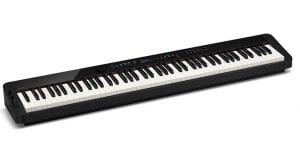
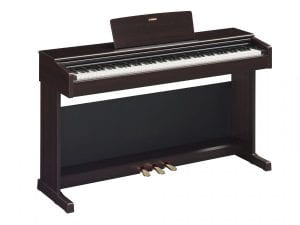

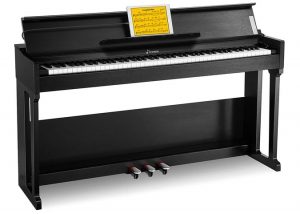
At first, I was not sure if I can get a good piano under €1000, but after reading reviews online, I found your list of best pianos under $1000 which means my budget of €1000 is way more. So, after going through the whole article and reading your honest reviews I have decided to buy Yamaha DGX660B digital piano.